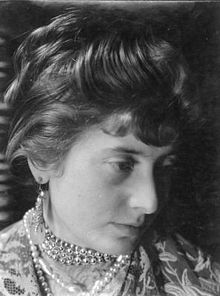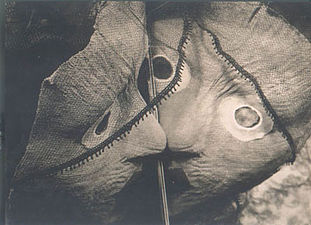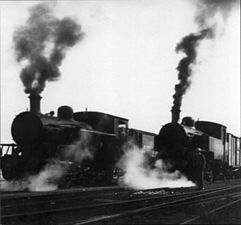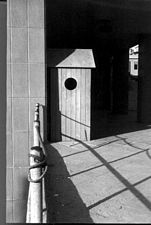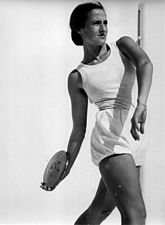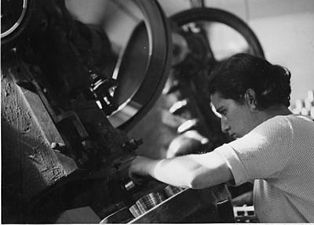Liselotte Grschebina
Liselotte Grschebina (Grjebina) (born May 2, 1908 in Karlsruhe , † June 14, 1994 in Petach Tikva , Israel ) was an Israeli-German photographer .
biography
Liselotte Grschebina (Grjebina) was born on May 2, 1908 in Karlsruhe, Germany . Her parents, Rosa and Otto Billigheimer, were both Jewish . Otto Billigheimer fell during the First World War in 1916. Grschebina studied painting and graphic design at the Badische Landeskunstschule (BLK) in Karlsruhe from 1925 to 1929 and then continued her studies in commercial photography at the Academy of Fine Arts in Stuttgart . In 1932 she opened the photo studio "Bilfoto", with which she specialized in child photography and in the course of which she also became a training company.
1933 due to the takeover of the Nazis and their policy of expropriation of Jewish citizens, Grschebina was forced to close her studio. Before she left Germany, she married Dr. Jacob (Jasha) Grschebin. The couple came to Tel Aviv in March 1934 . In the same year Grschebina opened the Ishon Studio there on Allenby Strasse, together with her friend Ellen Rosenberg (Auerbach), who had already worked with her in the Berlin photo studio.
The studio was closed again in 1936 when Rosenberg left Israel. From then on, Grebschina continued her work without a studio. From 1934 to 1947 she was the official photographer of the Zionist women's organization WIZO . In 1939 she founded the Palestine Professional Photographers Association (PPPA) together with other photographers of German origin , the first independent organization of photographers in the country. From the 1930s to the 1950s, Grschebina also took photos for Palestine Railways , the dairy product company Tnuva , within various Kibbuze and for some smaller commercial clients.
Liselotte Grschebina died on June 14, 1994 at the age of 86 in Petach Tikva. Her photographic archive was bequeathed to the Israel Museum in Jerusalem by her son, Beni Gjebin, and his wife Rina .
style
Liselotte Grschebina's photographs, accidentally rediscovered in a kitchen cupboard in Tel Aviv, reveal a talent for photography that might have remained hidden. Grschebina emigrated from Germany to Palestine in 1934 as an experienced professional photographer. It was influenced by the revolutionary movements in the Weimar Republic , the New Objectivity in painting and the New Vision in photography, as well as a number of renowned professors, including Karl Hubbuch and Wilhelm Schnarrenberger . In contrast to other of her colleagues, who tried to determine their identity in the collective Zionist endeavors by documenting and praising them in their work, Grschebina did not use photography to develop her identity. On the contrary, her style was already pronounced and she stuck to the ideals and principles of Weimar art in her new home, where she continued to develop it. The exhibition at the Israel Museum showed a larger section of 1,800 photographs from her estate for the first time and presented both Grschebina's life and her work to the public for the first time. Grschebina's artistic work is clearly rooted in the New Seeing, which defined photography as an independent artistic activity and called on photographers to portray their motifs in a new, different way. Grschebina's style characterizes its perspectivity, the strong diagonals and reflections. In it she plays with light and shadow that create geometric shapes and thereby determine the composition of her photographs .
In Israel, Grschebina mostly worked outside the studio, where she perceived her surroundings with a keen, impartial eye. For example, she photographed people who unconsciously went about their daily routine with the camera. The viewer of Grschebina's photographs thus becomes an observer who nevertheless receives an insight and can develop a new, objective perspective on the subject of the photograph. This “objective” image, in contrast to the posed, subjective photography, was based on the photographer like László Moholy-Nagy , who is considered to be the genius of the new vision.
- Pictures by Liselotte Grschebina
Rosh Hanikra , c. 1960, Israel Museum Collection, B01.0244 (0129)
Exhibitions
- 1937: Participation in an international exhibition in Paris.
- 1938: Participation in the group exhibition "Old Life - New Life" of the T'munah photographers' association, exhibited in their premises in Kantstrasse Berlin.
- 1941: Participation in the group exhibition of the PPPA. Logos Bookstore, Tel Aviv.
- 2000: Summer - Time Frame: A Century of Photography in the Land of Israel. Israel Museum, Jerusalem.
- 2005: The New Hebrews - 100 Years of Israeli Art. Martin-Gropius-Bau , Berlin.
- October to December 2008: A woman with a camera: Liselotte Grschebina, Germany 1908 - Israel 1994. Ticho House, Jerusalem.
- 2009: A woman with a camera: Liselotte Grschebina, Germany 1908 - 1994 Israel . An exhibition by the Israel Museum, Jerusalem. Curator: Yudit Caplan. Martin-Gropius-Bau, Berlin.
literature
- Nathan Jeffay: The Old New Vision of Israeli-German Photograph. In: The Jewish Daily Forward , December 24, 2008.
- The Old Objectivity. Gallery. In: Haaretz , August 13, 2010. (Hebrew)
Web links
- Liselotte Grschebina in the Information Center for Israeli Art
- Liselotte Grschebin in the Europeana
Individual evidence
- ↑ A woman with a camera: Liselotte Grschebina, Germany 1908 - 1994 Israel. An exhibition by the Israel Museum, Jerusalem. Curator: Yudit Caplan, Martin-Gropius-Bau, Berlin, 2009.
- ↑ a b Woman with a Camera: Liselotte Grschebina . Israel Museum. Retrieved on September 27, 2011. ( Page no longer available , search in web archives ) Info: The link was automatically marked as defective. Please check the link according to the instructions and then remove this notice.
- ↑ Yudit Caplan: Woman with a Camera: Liselotte Grschebina, Germany 1908 - Israel 1994 The Israel Museum, Jerusalem of 2008.
- ^ Time Frame: A Century of Photography in the Land of Israel . Israel Museum. Retrieved on September 27, 2011. ( Page no longer available , search in web archives ) Info: The link was automatically marked as defective. Please check the link according to the instructions and then remove this notice.
- ^ The Old New Vision of Israeli-German Photograph . In: Jewish Daily Forward , December 24, 2008. Retrieved September 27, 2011.
| personal data | |
|---|---|
| SURNAME | Grschebina, Liselotte |
| ALTERNATIVE NAMES | Cheapheimer, Liselotte |
| BRIEF DESCRIPTION | Israeli-German photographer |
| DATE OF BIRTH | May 2, 1908 |
| PLACE OF BIRTH | Karlsruhe |
| DATE OF DEATH | June 14, 1994 |
| Place of death | Petach Tikva |
